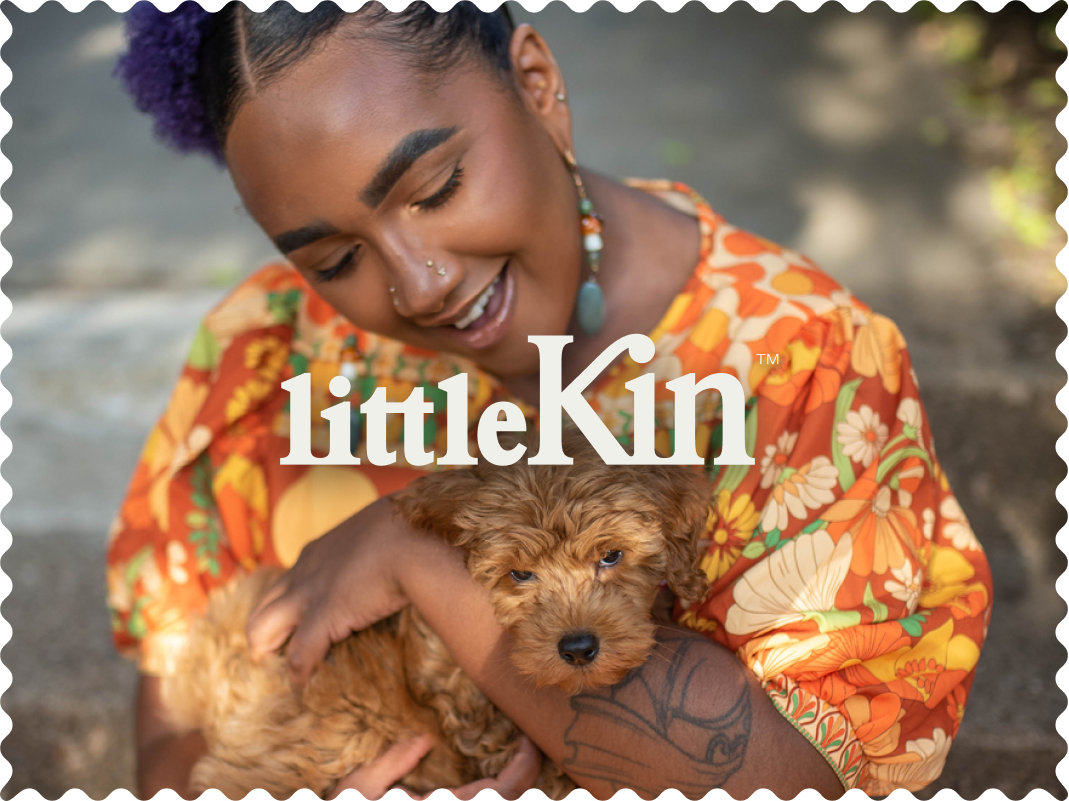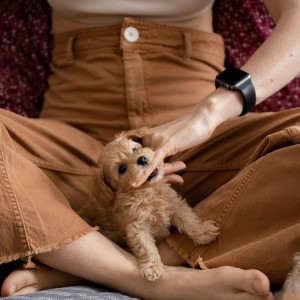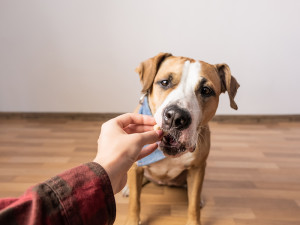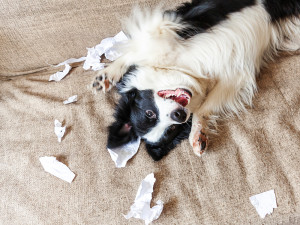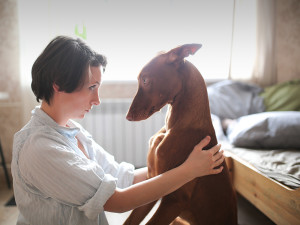
Share Article
In This Article:
How To Stop A Puppy From Nipping My Puppy Won’t Stop Biting Me, I’ve Tried Everything
Nipping is a normal puppy behavior. When learning and growing, nipping is a way puppies learn bite inhibition. Bite inhibition is how hard a dog bites down when it chews, using its jaws as its only form of communication. Allowing a puppy to bite and teaching them what hurts and does not hurt is an important part of puppyhood.
When puppies bite their siblings or their mom during play, you may notice the puppies or mother stop playing. If you see them stop playing, you can yelp, give a correction, or ignore the biting suspect they are teaching that puppy. It teaches them that the bite they gave was unacceptable and too hard. If they allow the play to continue, then that bite was given at an acceptable level.
This is how a puppy learns how to use their mouth in a gentle way. If your puppy is taken away from their siblings at a very young age, it is your job to help teach them appropriate bite inhibition. As always, consistency, early training, and positive reinforcement are key to training your puppy to stop nipping and foster appropriate bite inhibition where needed.

How to stop a puppy from nipping
Stop all play and movement.
When your puppy bites you hard, stop all play and movement. If you start running or pulling away, your puppy is going to think it is a game and will engage more. Ignoring goes a long way. That pause will help them understand that the bite is unacceptable. If they have your clothing in their mouth, bring your hand down to where their mouth is, grab onto the fabric that is close to their mouth, and hold it still so they cannot play tug with it. You can try to distract them or replace the item they are biting on if needed, but stopping all play and movement will be the most effective way.
Turn away from them.
Have you ever watched two dogs engaging in play? When their play gets too rough, you may see one dog stop and look away. The dog is telling the other dog they did not like that or is asking to please slow down. Dogs learn a lot from body language. After a nip, turn away from your dog and ignore them. Count to 15 in your head before reengaging with them. If they go to nip you again, ignore them again — consistency is key here.
Practice calm handling.
As much as it is fun to get excited with your puppy, it is just as important to teach them how to be calm. Calmly pet your puppy if they begin to get excited and jump or become too riled up to stop and wait. Once they have calmed down and all four paws are on the ground, resume petting them. Repeat this over and over, only petting your puppy once they chill out. This will teach them impulse control and how to stay calm while being pet.
Choose large toys and keep them away from your body.
Using longer, puppy appropriate-sized toys can help prevent nipping. The longer toy will give distance between you and your puppy hopefully keeping them from nipping you. Just keep in mind that puppies have baby teeth and playing rough games, such as tug, is not the best (until they are older). Be sure to play gently and try not to pull it from their mouth in a way that may hurt their teeth or gums.
Try non-contact play.
Games like fetch that keep your puppy further away from you can help prevent nipping. When your puppy gets back to you after retrieving the ball, say, “Drop it!” with a treat in your hand. When they drop the ball, give them the treat.
Provide plenty of exercise and mental stimulation.
Finding a balance between exercise, mental stimulation, and sleep is important for your puppy. Too much or too little of each can cause them to act out. Fetch and tug are great ways to get some energy out. A “sniffari” is a great way to get your puppy exercise and mental stimulation. This is when you take them on a walk and let them be the guide, allowing them to sniff and walk where they please.
Schedule nap time.
A puppy should be awake for about an hour and then take a few-hour nap. Sticking to a schedule will help you keep them healthy and avoid behavior problems from overexhaustion. Nap time is the perfect time to practice crate training.
Redirect their nipping to a toy.
It is handy to keep toys near you at all times when you have a new puppy; that way, you can redirect any nipping when needed. If your puppy goes to nip, grab a toy and distract them. Take the toy and drag it along the floor in a similar way to prey. This should distract your puppy from nipping because you are enticing them to take the toy instead.
Teach kids how to interact with your puppy.
Showing children how to play and interact with a puppy is just as important as training your puppy. You want your puppy to feel safe around children and adults. Teach your child appropriate ways to pet and play your new pet; this will help foster a positive relationship.
Do not allow your child to hug a dog, pull their tail, or engage with them in any way that may make them uncomfortable. This may cause them to feel unsafe, which will make them bite or nip.
Yelp when they bite you.
Try to act like a dog when your puppy bites you. If you get nipped, make a loud yelp and then ignore your puppy. You are creating a scenario similar to what their puppy siblings would do which will help them learn that nipping is unacceptable.
Don’t use their crate as a punishment.
A crate should be a safe haven for your puppy and should never be used as punishment. If you do, your puppy will eventually stop going in the crate because they associate it with something bad. The crate should only be used for eating and relaxing; this will ensure that the relationship stays positive.
My puppy won’t stop biting me; I’ve tried everything.
Seeking the help of a trained professional is a great way to build the dog you have always been looking for. Even if you are not having any difficulties, taking a group training class is a great way to learn how to have the best training tools in your back pocket for your little pup.
If you are finding that you are struggling in any area of training, you should reach out to a professional in your area. Finding a certified professional dog trainer who specializes in positive reinforcement is in your puppy’s best interest. Head to CCPDT.orgopens in new tab to find someone local to you.
Bottom line
Nipping is a normal puppy behavior that is important to nip in the bud. Staying consistent and using positive reinforcement will help you train your puppy in a healthy way. Keeping them mentally stimulated, exercised, and well-rested will help prevent some nipping behaviors. When you feel like you are struggling and have tried everything, reach out to a trainer for help.
References
“All about Puppy Training - Denali National Park & Preserve (U.S. National Park Service).” Nps.gov, 2017, www.nps.gov/dena/blogs/all-about-puppy-training.htmopens in new tab. Accessed 3 June 2025.
American Veterinary Medical Association. “Dog Bite Prevention.” American Veterinary Medical Association, 2023, www.avma.org/resources-tools/pet-owners/dog-bite-preventionopens in new tab.
“How to Stop Attention-Seeking Behavior | Cummings School of Veterinary Medicine.” Vet.tufts.edu, vet.tufts.edu/news-events/news/how-stop-attention-seeking-behavioropens in new tab.
“How to Stop a Dog from Biting / Nipping.” The Daily Collegian, 18 Nov. 2022, www.psucollegian.com/studentreviews/how-to-stop-dog-from-biting/article_fcf9305c-6762-11ed-ae1d-2fa46e6f55ef.htmlopens in new tab. Accessed 3 June 2025.
Kutsumi, Ai, et al. “Importance of Puppy Training for Future Behavior of the Dog.” Journal of Veterinary Medical Science, vol. 75, no. 2, 2013, pp. 141–149, https://doi.org/10.1292/jvms.12-0008opens in new tab.
“Managing Mouthy Behaviors | Indoor Pet Initiative.” Osu.edu, 2025, indoorpet.osu.edu/dogs/puppy/mouthingopens in new tab. Accessed 3 June 2025.
“Puppy Training.” Lanecountyor.gov, 2016, www.lanecountyor.gov/cms/One.aspx?portalId=3585881&pageId=6086579opens in new tab. Accessed 3 June 2025.
Vieira de Castro, Ana Catarina, et al. “Improving Dog Training Methods: Efficacy and Efficiency of Reward and Mixed Training Methods.” PLOS ONE, vol. 16, no. 2, 19 Feb. 2021, p. e0247321, www.ncbi.nlm.nih.gov/pmc/articles/PMC7895348/opens in new tab, https://doi.org/10.1371/journal.pone.0247321opens in new tab.
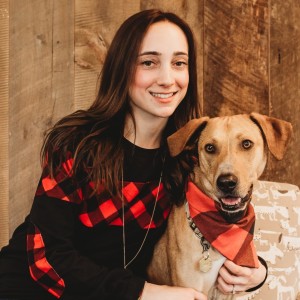
Danielle Vrabel, CPDT-KA
Danielle Vrabel is a dog trainer who earned her CPDT-KA in 2020. Danielle is a proud pet mom of five pets: two dogs, two cats, and a corn snake. Danielle has fostered over ten dogs and fifteen cats and kittens, as well as helped train shelter dogs before they are adopted. Both of Danielle’s dogs are pet therapy dogs, where she also volunteers her time helping evaluate future therapy dogs.
Related articles
![pet lover concept with mini dog on woman leg. sitting in room at home]()
What’s the Deal, Mouthy Puppies? Why Bite Inhibition Matters
How to teach your pup to play nice.
“How Do I Get My Puppy to Stop Biting My Ankles?”
Dog trainer Robert Haussmann’s tips for dealing with an attention-seeking puppy.
![Dog gently takes treat from owner's hand]()
How to Teach Your Dog to Take Treats Gently
And save your skin.
Why Does My Dog Nibble on Me?
Those little teeth are sweet, but they definitely don’t feel good on your hand.
![Puppy laying in torn up paper on the couch]()
New Puppy Driving You Nuts? Here’s How to Deal
The beginning of puppy parenthood can be rough, but it does get better — especially when you implement this advice.
![Woman looks eye to eye at Pharaoh's dog on floor in bedroom]()
“How Can I Tame a Sassy Pup?”
Internationally renowned dog trainer Victoria Stilwell's tips for training pushy puppies.
